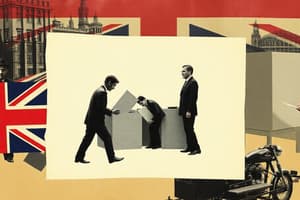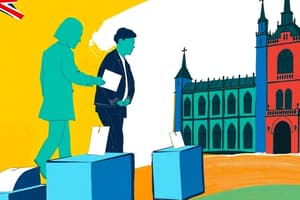Podcast
Questions and Answers
Which party has traditionally had a majority of voters in England, particularly in the South?
Which party has traditionally had a majority of voters in England, particularly in the South?
- Conservative Party (correct)
- Green Party
- Liberal Democrats
- Labour Party
What has been the trend in voting loyalty for the two major political parties from 1951 to 2010?
What has been the trend in voting loyalty for the two major political parties from 1951 to 2010?
- Increased significantly
- Remained stable
- Fluctuated wildly
- Decreased substantially (correct)
What major demographic change occurred in the voting base of the Labour Party from 1964 to 1983?
What major demographic change occurred in the voting base of the Labour Party from 1964 to 1983?
- Decrease in working-class support (correct)
- Increase in manual workers' support
- Decline in middle-class voters
- Increase in rural voters
What strategy did the Labour Party adopt to win conservative seats in the South?
What strategy did the Labour Party adopt to win conservative seats in the South?
Which voting behavior trend has become fashionable among voters in recent elections?
Which voting behavior trend has become fashionable among voters in recent elections?
Flashcards
North-South Divide
North-South Divide
A pattern where voters in the north of the UK tend to support Labour, while voters in the south tend to support the Conservatives.
Decline in Class Loyalty
Decline in Class Loyalty
A shift in voting behavior where the traditional class-based loyalties to parties decreased over time. This is linked to changes in the size of different social classes.
Negative Voting
Negative Voting
A voting pattern where people vote not because they strongly support a party, but to prevent a party they dislike from winning.
Low Voter Turnout
Low Voter Turnout
Signup and view all the flashcards
Political Centerization
Political Centerization
Signup and view all the flashcards
Study Notes
Electoral Trends Since 1979
- Growing north-south divide in voting patterns since 1979
- Conservative voters predominantly in southern England
- Labour voters concentrated in industrial areas of the Midlands, North, and Scotland
- This division has intensified over the last 30 years
- 2010 election map showed rural England largely supporting Conservatives (blue)
- Labour predominantly won large cities in the industrial North, West Midlands, South Wales, and Scottish Lowlands
- Labour's reliance on large cities, which have experienced population decline, necessitates attracting middle-class support to win traditionally Conservative seats in the South
- Labour had to adjust policies to appeal to the centre to gain middle-class support and win seats in the south
Changing Class Demographics in Voting
- Historically, Labour enjoyed strong support from manual and skilled workers
- The working class voter proportion declined from 50% in 1964 to 33.3% by 1983
- The middle class voter proportion increased from 33.3% to 50% over the same period
- Decrease in voting loyalty to specific parties based on class
- Overall party loyalty has decreased
- In 1951, 97% of voters supported the two largest parties; this was down to 65% in 2010
- Negative voting (to keep a disliked party out of power) has become common
Voter Turnout and Political Engagement
- Recent elections have shown a declining voter turnout, a significant concern
- A large segment of the population is seemingly uninterested in or disillusioned with the political system
Younger Generation and Political Engagement
- Younger generations demonstrate a lack of engagement with the political process, a worrying concern for the future
Studying That Suits You
Use AI to generate personalized quizzes and flashcards to suit your learning preferences.




